Essay: Development of Contemporary Tourism and its Various Impacts
VerifiedAdded on 2023/06/17
|7
|2254
|130
Essay
AI Summary
This essay provides an overview of contemporary tourism, tracing its development from ancient times to the modern era, highlighting the shift towards international travel, technology integration, and diverse tourism types. It delves into the positive and negative economic impacts, such as foreign exchange earnings and job creation versus opportunity costs and economic leakage. The analysis extends to environmental impacts, contrasting heritage preservation and improved environmental management with pollution and resource scarcity. Furthermore, the essay examines socio-cultural impacts, noting the increase in cross-cultural communication alongside the potential for cultural clashes. The conclusion emphasizes the importance of fostering sustainable tourism for economic benefits, environmental protection, and global peace, advocating for responsible practices to mitigate negative consequences and ensure a sustainable future for tourism.
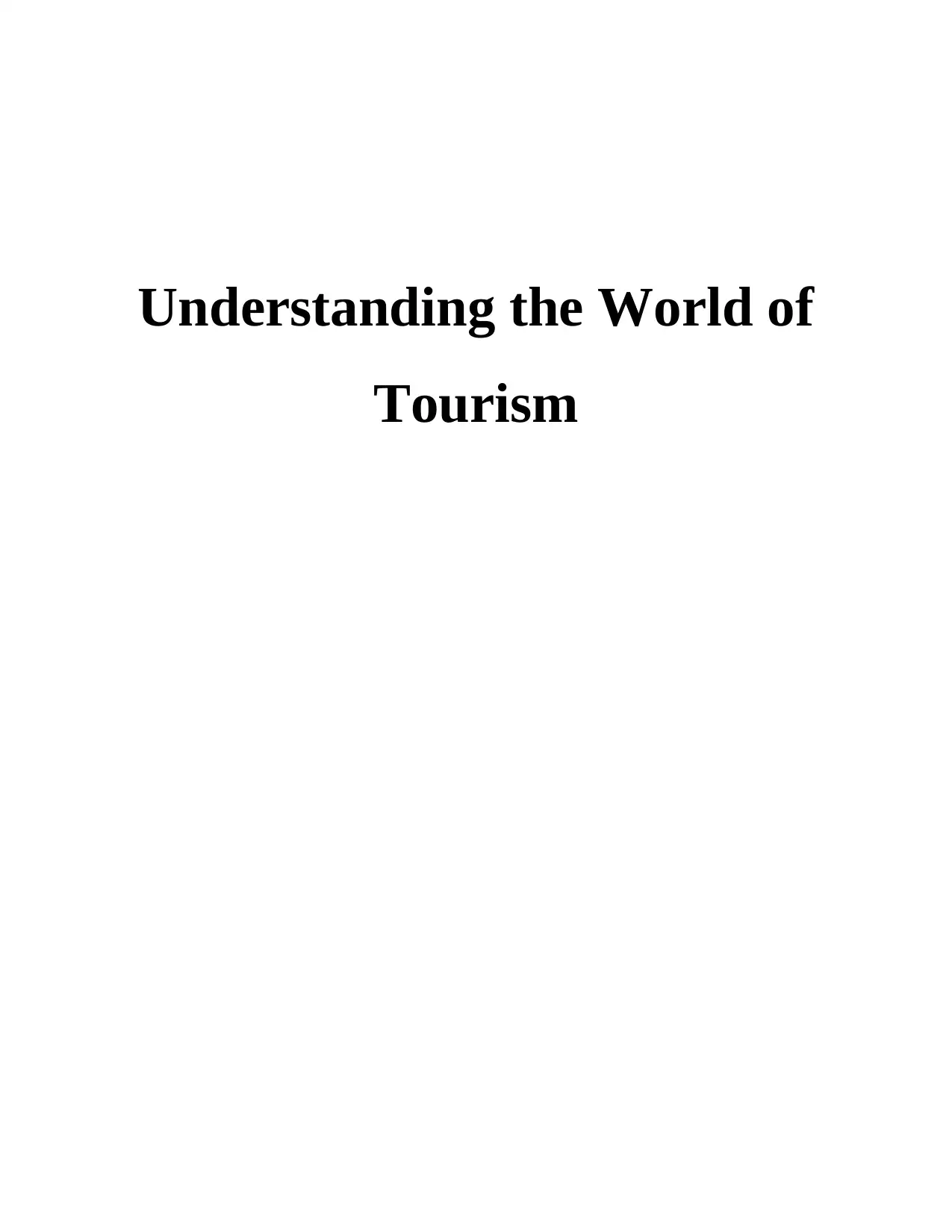
Understanding the World of
Tourism
Tourism
Paraphrase This Document
Need a fresh take? Get an instant paraphrase of this document with our AI Paraphraser
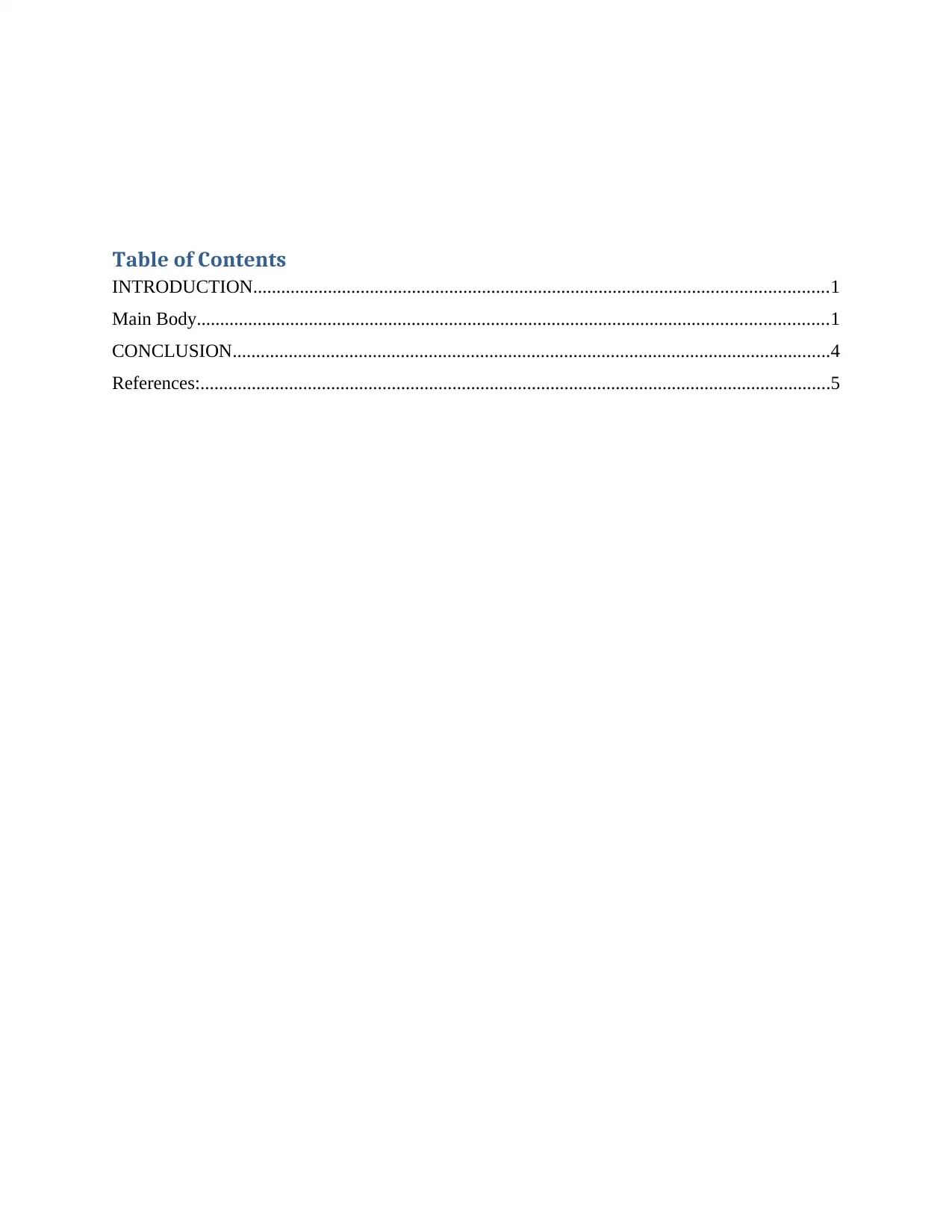
Table of Contents
INTRODUCTION...........................................................................................................................1
Main Body.......................................................................................................................................1
CONCLUSION................................................................................................................................4
References:.......................................................................................................................................5
INTRODUCTION...........................................................................................................................1
Main Body.......................................................................................................................................1
CONCLUSION................................................................................................................................4
References:.......................................................................................................................................5
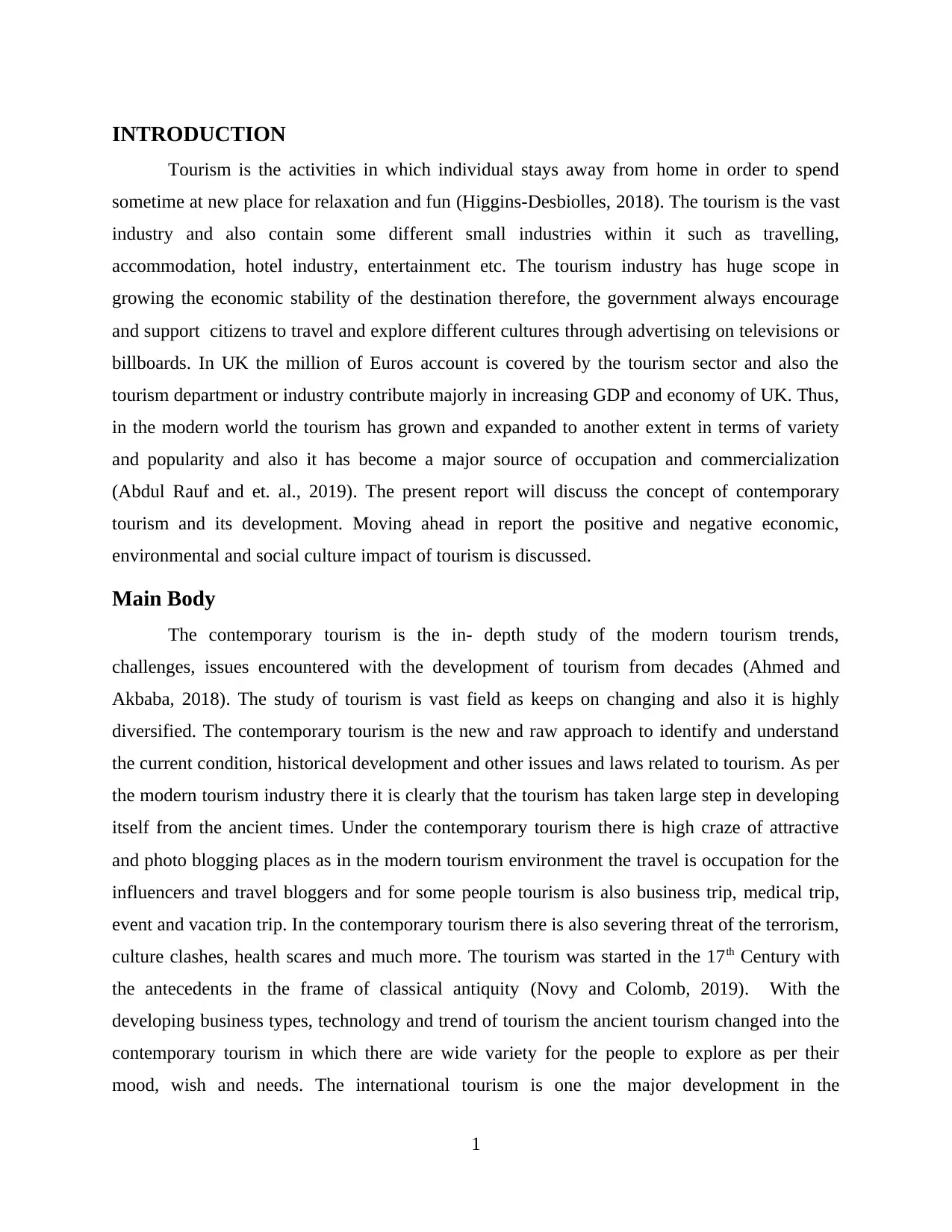
INTRODUCTION
Tourism is the activities in which individual stays away from home in order to spend
sometime at new place for relaxation and fun (Higgins-Desbiolles, 2018). The tourism is the vast
industry and also contain some different small industries within it such as travelling,
accommodation, hotel industry, entertainment etc. The tourism industry has huge scope in
growing the economic stability of the destination therefore, the government always encourage
and support citizens to travel and explore different cultures through advertising on televisions or
billboards. In UK the million of Euros account is covered by the tourism sector and also the
tourism department or industry contribute majorly in increasing GDP and economy of UK. Thus,
in the modern world the tourism has grown and expanded to another extent in terms of variety
and popularity and also it has become a major source of occupation and commercialization
(Abdul Rauf and et. al., 2019). The present report will discuss the concept of contemporary
tourism and its development. Moving ahead in report the positive and negative economic,
environmental and social culture impact of tourism is discussed.
Main Body
The contemporary tourism is the in- depth study of the modern tourism trends,
challenges, issues encountered with the development of tourism from decades (Ahmed and
Akbaba, 2018). The study of tourism is vast field as keeps on changing and also it is highly
diversified. The contemporary tourism is the new and raw approach to identify and understand
the current condition, historical development and other issues and laws related to tourism. As per
the modern tourism industry there it is clearly that the tourism has taken large step in developing
itself from the ancient times. Under the contemporary tourism there is high craze of attractive
and photo blogging places as in the modern tourism environment the travel is occupation for the
influencers and travel bloggers and for some people tourism is also business trip, medical trip,
event and vacation trip. In the contemporary tourism there is also severing threat of the terrorism,
culture clashes, health scares and much more. The tourism was started in the 17th Century with
the antecedents in the frame of classical antiquity (Novy and Colomb, 2019). With the
developing business types, technology and trend of tourism the ancient tourism changed into the
contemporary tourism in which there are wide variety for the people to explore as per their
mood, wish and needs. The international tourism is one the major development in the
1
Tourism is the activities in which individual stays away from home in order to spend
sometime at new place for relaxation and fun (Higgins-Desbiolles, 2018). The tourism is the vast
industry and also contain some different small industries within it such as travelling,
accommodation, hotel industry, entertainment etc. The tourism industry has huge scope in
growing the economic stability of the destination therefore, the government always encourage
and support citizens to travel and explore different cultures through advertising on televisions or
billboards. In UK the million of Euros account is covered by the tourism sector and also the
tourism department or industry contribute majorly in increasing GDP and economy of UK. Thus,
in the modern world the tourism has grown and expanded to another extent in terms of variety
and popularity and also it has become a major source of occupation and commercialization
(Abdul Rauf and et. al., 2019). The present report will discuss the concept of contemporary
tourism and its development. Moving ahead in report the positive and negative economic,
environmental and social culture impact of tourism is discussed.
Main Body
The contemporary tourism is the in- depth study of the modern tourism trends,
challenges, issues encountered with the development of tourism from decades (Ahmed and
Akbaba, 2018). The study of tourism is vast field as keeps on changing and also it is highly
diversified. The contemporary tourism is the new and raw approach to identify and understand
the current condition, historical development and other issues and laws related to tourism. As per
the modern tourism industry there it is clearly that the tourism has taken large step in developing
itself from the ancient times. Under the contemporary tourism there is high craze of attractive
and photo blogging places as in the modern tourism environment the travel is occupation for the
influencers and travel bloggers and for some people tourism is also business trip, medical trip,
event and vacation trip. In the contemporary tourism there is also severing threat of the terrorism,
culture clashes, health scares and much more. The tourism was started in the 17th Century with
the antecedents in the frame of classical antiquity (Novy and Colomb, 2019). With the
developing business types, technology and trend of tourism the ancient tourism changed into the
contemporary tourism in which there are wide variety for the people to explore as per their
mood, wish and needs. The international tourism is one the major development in the
1
⊘ This is a preview!⊘
Do you want full access?
Subscribe today to unlock all pages.

Trusted by 1+ million students worldwide
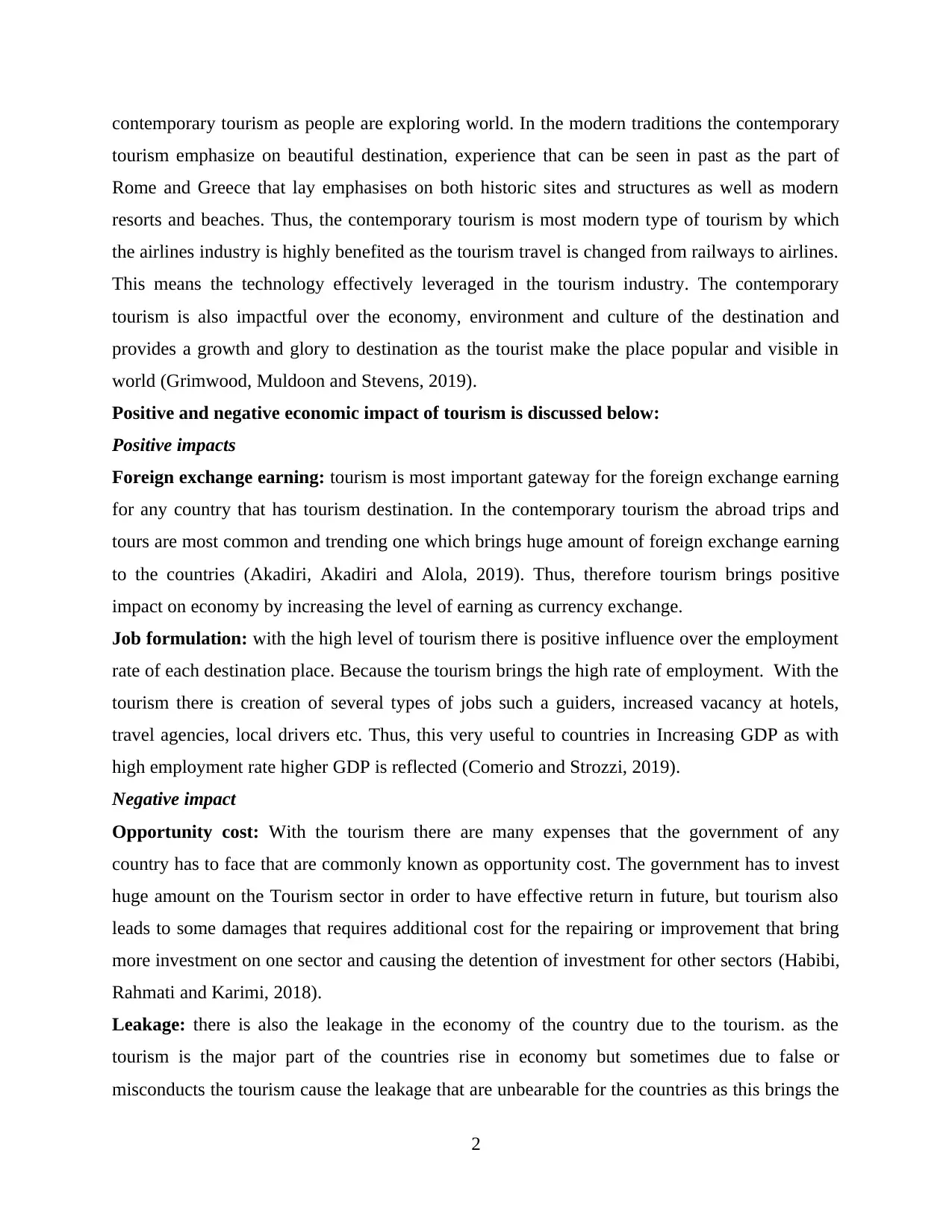
contemporary tourism as people are exploring world. In the modern traditions the contemporary
tourism emphasize on beautiful destination, experience that can be seen in past as the part of
Rome and Greece that lay emphasises on both historic sites and structures as well as modern
resorts and beaches. Thus, the contemporary tourism is most modern type of tourism by which
the airlines industry is highly benefited as the tourism travel is changed from railways to airlines.
This means the technology effectively leveraged in the tourism industry. The contemporary
tourism is also impactful over the economy, environment and culture of the destination and
provides a growth and glory to destination as the tourist make the place popular and visible in
world (Grimwood, Muldoon and Stevens, 2019).
Positive and negative economic impact of tourism is discussed below:
Positive impacts
Foreign exchange earning: tourism is most important gateway for the foreign exchange earning
for any country that has tourism destination. In the contemporary tourism the abroad trips and
tours are most common and trending one which brings huge amount of foreign exchange earning
to the countries (Akadiri, Akadiri and Alola, 2019). Thus, therefore tourism brings positive
impact on economy by increasing the level of earning as currency exchange.
Job formulation: with the high level of tourism there is positive influence over the employment
rate of each destination place. Because the tourism brings the high rate of employment. With the
tourism there is creation of several types of jobs such a guiders, increased vacancy at hotels,
travel agencies, local drivers etc. Thus, this very useful to countries in Increasing GDP as with
high employment rate higher GDP is reflected (Comerio and Strozzi, 2019).
Negative impact
Opportunity cost: With the tourism there are many expenses that the government of any
country has to face that are commonly known as opportunity cost. The government has to invest
huge amount on the Tourism sector in order to have effective return in future, but tourism also
leads to some damages that requires additional cost for the repairing or improvement that bring
more investment on one sector and causing the detention of investment for other sectors (Habibi,
Rahmati and Karimi, 2018).
Leakage: there is also the leakage in the economy of the country due to the tourism. as the
tourism is the major part of the countries rise in economy but sometimes due to false or
misconducts the tourism cause the leakage that are unbearable for the countries as this brings the
2
tourism emphasize on beautiful destination, experience that can be seen in past as the part of
Rome and Greece that lay emphasises on both historic sites and structures as well as modern
resorts and beaches. Thus, the contemporary tourism is most modern type of tourism by which
the airlines industry is highly benefited as the tourism travel is changed from railways to airlines.
This means the technology effectively leveraged in the tourism industry. The contemporary
tourism is also impactful over the economy, environment and culture of the destination and
provides a growth and glory to destination as the tourist make the place popular and visible in
world (Grimwood, Muldoon and Stevens, 2019).
Positive and negative economic impact of tourism is discussed below:
Positive impacts
Foreign exchange earning: tourism is most important gateway for the foreign exchange earning
for any country that has tourism destination. In the contemporary tourism the abroad trips and
tours are most common and trending one which brings huge amount of foreign exchange earning
to the countries (Akadiri, Akadiri and Alola, 2019). Thus, therefore tourism brings positive
impact on economy by increasing the level of earning as currency exchange.
Job formulation: with the high level of tourism there is positive influence over the employment
rate of each destination place. Because the tourism brings the high rate of employment. With the
tourism there is creation of several types of jobs such a guiders, increased vacancy at hotels,
travel agencies, local drivers etc. Thus, this very useful to countries in Increasing GDP as with
high employment rate higher GDP is reflected (Comerio and Strozzi, 2019).
Negative impact
Opportunity cost: With the tourism there are many expenses that the government of any
country has to face that are commonly known as opportunity cost. The government has to invest
huge amount on the Tourism sector in order to have effective return in future, but tourism also
leads to some damages that requires additional cost for the repairing or improvement that bring
more investment on one sector and causing the detention of investment for other sectors (Habibi,
Rahmati and Karimi, 2018).
Leakage: there is also the leakage in the economy of the country due to the tourism. as the
tourism is the major part of the countries rise in economy but sometimes due to false or
misconducts the tourism cause the leakage that are unbearable for the countries as this brings the
2
Paraphrase This Document
Need a fresh take? Get an instant paraphrase of this document with our AI Paraphraser
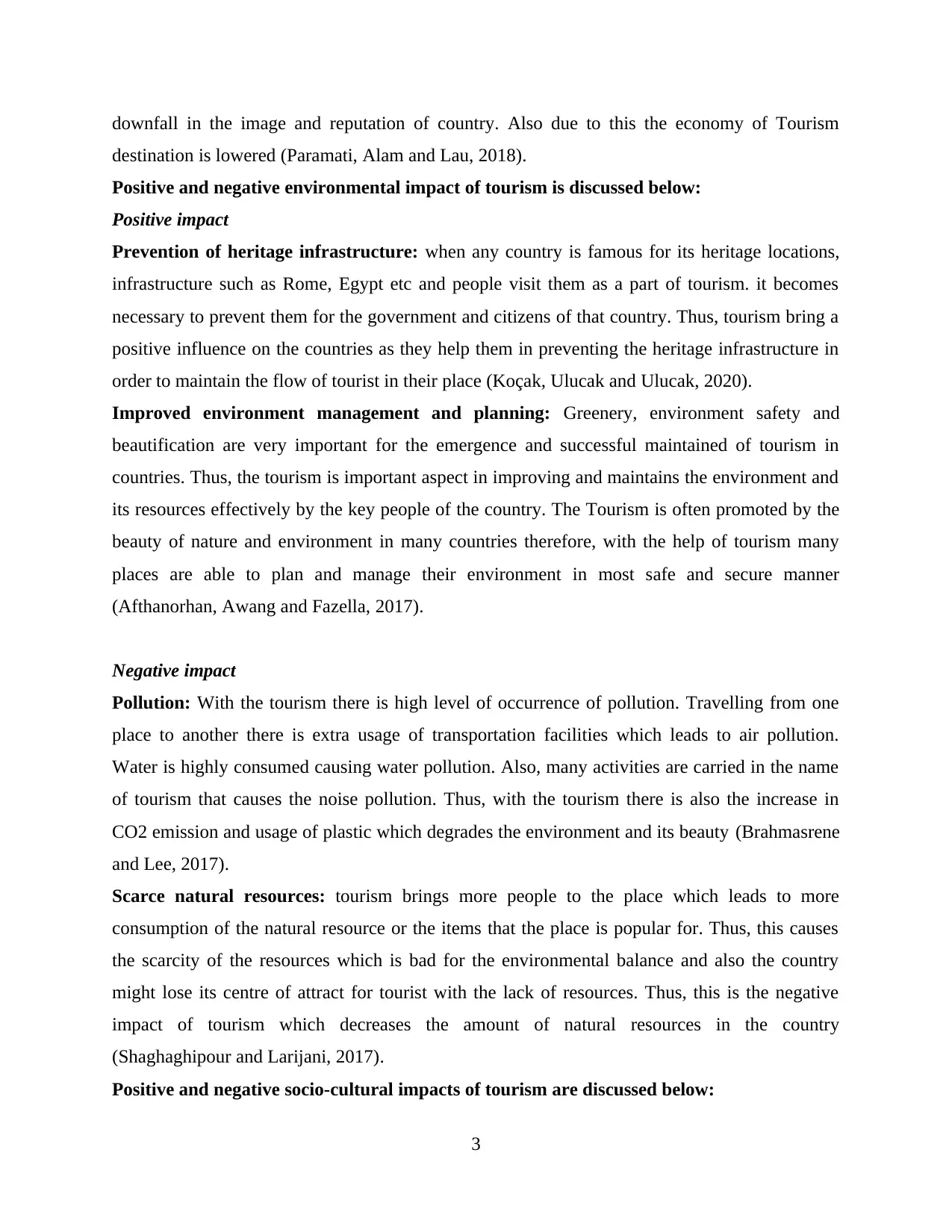
downfall in the image and reputation of country. Also due to this the economy of Tourism
destination is lowered (Paramati, Alam and Lau, 2018).
Positive and negative environmental impact of tourism is discussed below:
Positive impact
Prevention of heritage infrastructure: when any country is famous for its heritage locations,
infrastructure such as Rome, Egypt etc and people visit them as a part of tourism. it becomes
necessary to prevent them for the government and citizens of that country. Thus, tourism bring a
positive influence on the countries as they help them in preventing the heritage infrastructure in
order to maintain the flow of tourist in their place (Koçak, Ulucak and Ulucak, 2020).
Improved environment management and planning: Greenery, environment safety and
beautification are very important for the emergence and successful maintained of tourism in
countries. Thus, the tourism is important aspect in improving and maintains the environment and
its resources effectively by the key people of the country. The Tourism is often promoted by the
beauty of nature and environment in many countries therefore, with the help of tourism many
places are able to plan and manage their environment in most safe and secure manner
(Afthanorhan, Awang and Fazella, 2017).
Negative impact
Pollution: With the tourism there is high level of occurrence of pollution. Travelling from one
place to another there is extra usage of transportation facilities which leads to air pollution.
Water is highly consumed causing water pollution. Also, many activities are carried in the name
of tourism that causes the noise pollution. Thus, with the tourism there is also the increase in
CO2 emission and usage of plastic which degrades the environment and its beauty (Brahmasrene
and Lee, 2017).
Scarce natural resources: tourism brings more people to the place which leads to more
consumption of the natural resource or the items that the place is popular for. Thus, this causes
the scarcity of the resources which is bad for the environmental balance and also the country
might lose its centre of attract for tourist with the lack of resources. Thus, this is the negative
impact of tourism which decreases the amount of natural resources in the country
(Shaghaghipour and Larijani, 2017).
Positive and negative socio-cultural impacts of tourism are discussed below:
3
destination is lowered (Paramati, Alam and Lau, 2018).
Positive and negative environmental impact of tourism is discussed below:
Positive impact
Prevention of heritage infrastructure: when any country is famous for its heritage locations,
infrastructure such as Rome, Egypt etc and people visit them as a part of tourism. it becomes
necessary to prevent them for the government and citizens of that country. Thus, tourism bring a
positive influence on the countries as they help them in preventing the heritage infrastructure in
order to maintain the flow of tourist in their place (Koçak, Ulucak and Ulucak, 2020).
Improved environment management and planning: Greenery, environment safety and
beautification are very important for the emergence and successful maintained of tourism in
countries. Thus, the tourism is important aspect in improving and maintains the environment and
its resources effectively by the key people of the country. The Tourism is often promoted by the
beauty of nature and environment in many countries therefore, with the help of tourism many
places are able to plan and manage their environment in most safe and secure manner
(Afthanorhan, Awang and Fazella, 2017).
Negative impact
Pollution: With the tourism there is high level of occurrence of pollution. Travelling from one
place to another there is extra usage of transportation facilities which leads to air pollution.
Water is highly consumed causing water pollution. Also, many activities are carried in the name
of tourism that causes the noise pollution. Thus, with the tourism there is also the increase in
CO2 emission and usage of plastic which degrades the environment and its beauty (Brahmasrene
and Lee, 2017).
Scarce natural resources: tourism brings more people to the place which leads to more
consumption of the natural resource or the items that the place is popular for. Thus, this causes
the scarcity of the resources which is bad for the environmental balance and also the country
might lose its centre of attract for tourist with the lack of resources. Thus, this is the negative
impact of tourism which decreases the amount of natural resources in the country
(Shaghaghipour and Larijani, 2017).
Positive and negative socio-cultural impacts of tourism are discussed below:
3
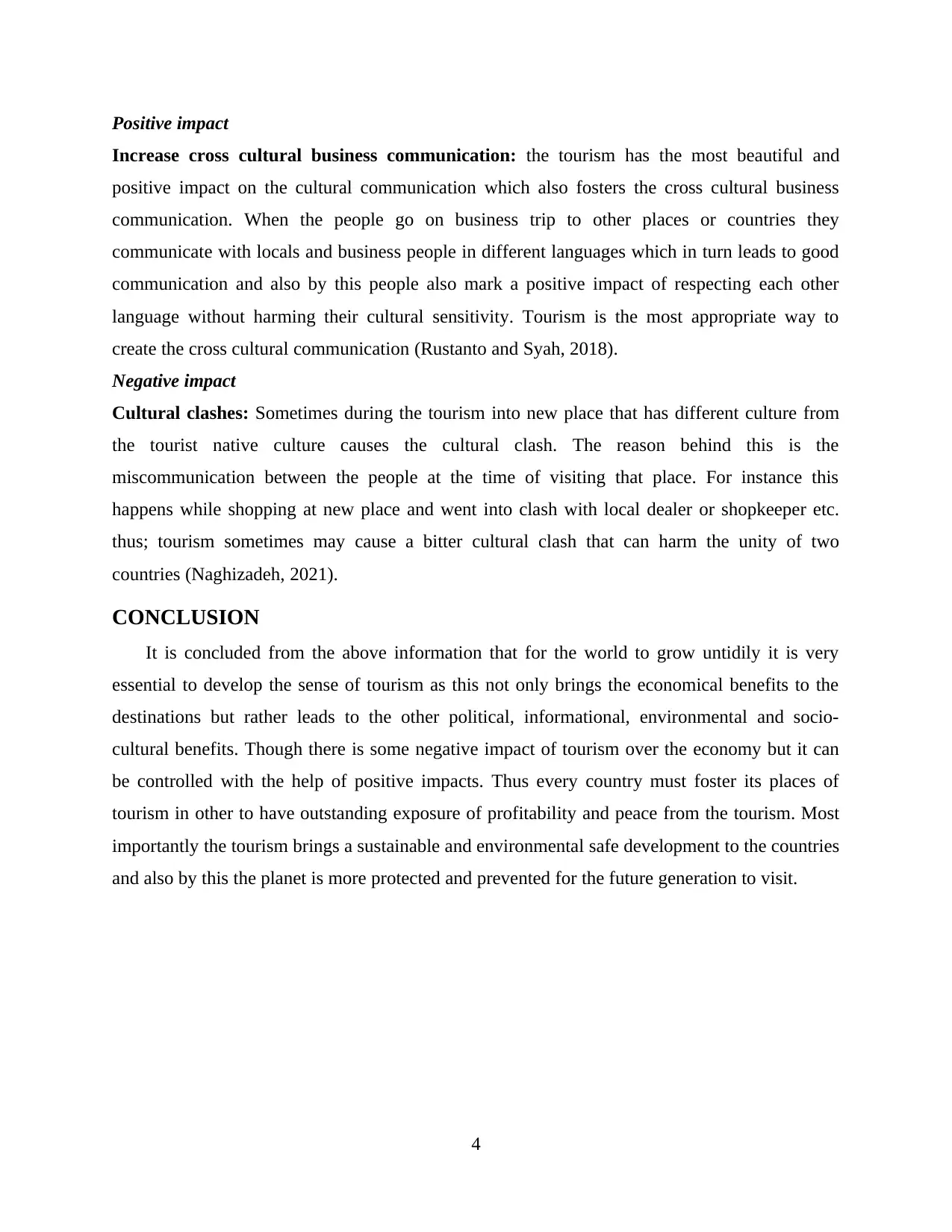
Positive impact
Increase cross cultural business communication: the tourism has the most beautiful and
positive impact on the cultural communication which also fosters the cross cultural business
communication. When the people go on business trip to other places or countries they
communicate with locals and business people in different languages which in turn leads to good
communication and also by this people also mark a positive impact of respecting each other
language without harming their cultural sensitivity. Tourism is the most appropriate way to
create the cross cultural communication (Rustanto and Syah, 2018).
Negative impact
Cultural clashes: Sometimes during the tourism into new place that has different culture from
the tourist native culture causes the cultural clash. The reason behind this is the
miscommunication between the people at the time of visiting that place. For instance this
happens while shopping at new place and went into clash with local dealer or shopkeeper etc.
thus; tourism sometimes may cause a bitter cultural clash that can harm the unity of two
countries (Naghizadeh, 2021).
CONCLUSION
It is concluded from the above information that for the world to grow untidily it is very
essential to develop the sense of tourism as this not only brings the economical benefits to the
destinations but rather leads to the other political, informational, environmental and socio-
cultural benefits. Though there is some negative impact of tourism over the economy but it can
be controlled with the help of positive impacts. Thus every country must foster its places of
tourism in other to have outstanding exposure of profitability and peace from the tourism. Most
importantly the tourism brings a sustainable and environmental safe development to the countries
and also by this the planet is more protected and prevented for the future generation to visit.
4
Increase cross cultural business communication: the tourism has the most beautiful and
positive impact on the cultural communication which also fosters the cross cultural business
communication. When the people go on business trip to other places or countries they
communicate with locals and business people in different languages which in turn leads to good
communication and also by this people also mark a positive impact of respecting each other
language without harming their cultural sensitivity. Tourism is the most appropriate way to
create the cross cultural communication (Rustanto and Syah, 2018).
Negative impact
Cultural clashes: Sometimes during the tourism into new place that has different culture from
the tourist native culture causes the cultural clash. The reason behind this is the
miscommunication between the people at the time of visiting that place. For instance this
happens while shopping at new place and went into clash with local dealer or shopkeeper etc.
thus; tourism sometimes may cause a bitter cultural clash that can harm the unity of two
countries (Naghizadeh, 2021).
CONCLUSION
It is concluded from the above information that for the world to grow untidily it is very
essential to develop the sense of tourism as this not only brings the economical benefits to the
destinations but rather leads to the other political, informational, environmental and socio-
cultural benefits. Though there is some negative impact of tourism over the economy but it can
be controlled with the help of positive impacts. Thus every country must foster its places of
tourism in other to have outstanding exposure of profitability and peace from the tourism. Most
importantly the tourism brings a sustainable and environmental safe development to the countries
and also by this the planet is more protected and prevented for the future generation to visit.
4
⊘ This is a preview!⊘
Do you want full access?
Subscribe today to unlock all pages.

Trusted by 1+ million students worldwide
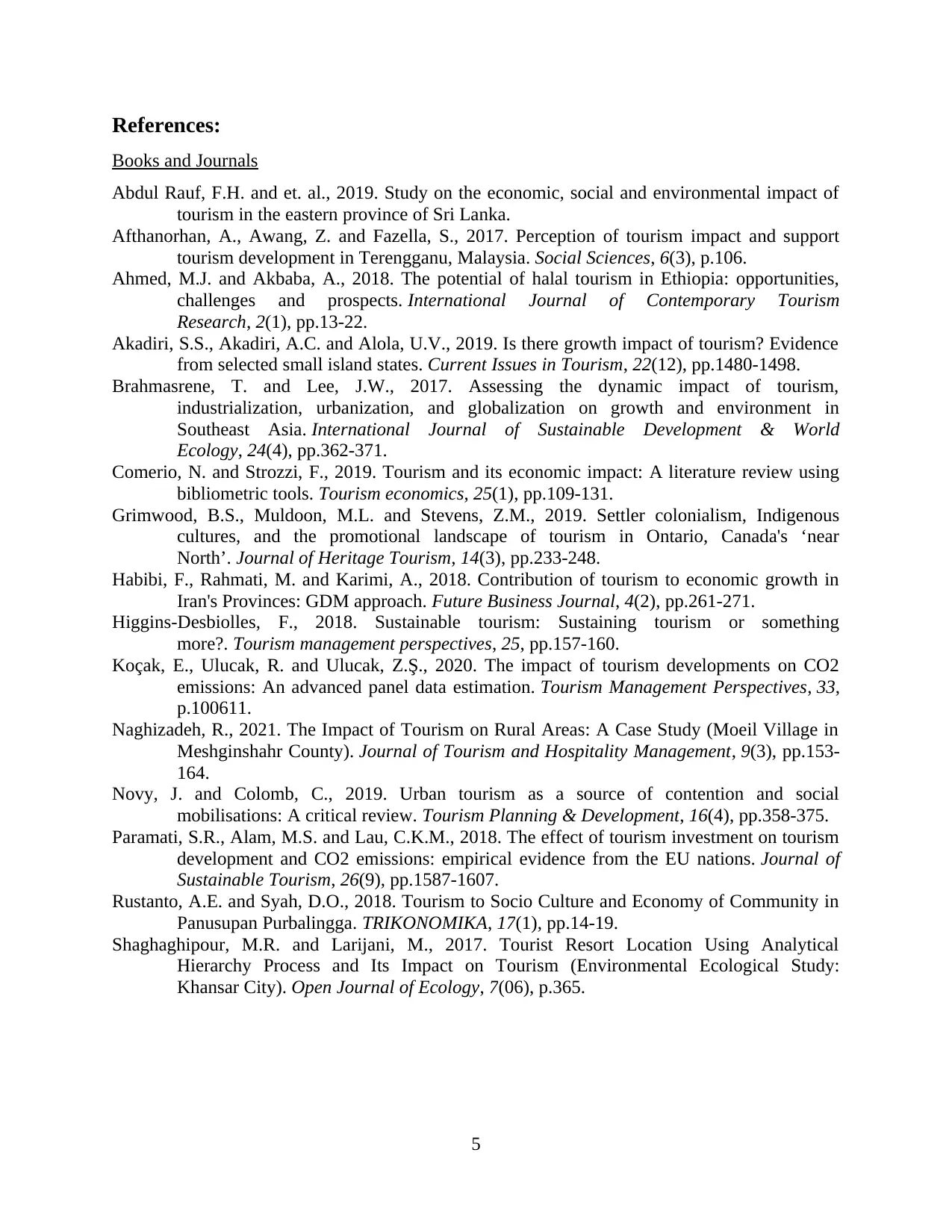
References:
Books and Journals
Abdul Rauf, F.H. and et. al., 2019. Study on the economic, social and environmental impact of
tourism in the eastern province of Sri Lanka.
Afthanorhan, A., Awang, Z. and Fazella, S., 2017. Perception of tourism impact and support
tourism development in Terengganu, Malaysia. Social Sciences, 6(3), p.106.
Ahmed, M.J. and Akbaba, A., 2018. The potential of halal tourism in Ethiopia: opportunities,
challenges and prospects. International Journal of Contemporary Tourism
Research, 2(1), pp.13-22.
Akadiri, S.S., Akadiri, A.C. and Alola, U.V., 2019. Is there growth impact of tourism? Evidence
from selected small island states. Current Issues in Tourism, 22(12), pp.1480-1498.
Brahmasrene, T. and Lee, J.W., 2017. Assessing the dynamic impact of tourism,
industrialization, urbanization, and globalization on growth and environment in
Southeast Asia. International Journal of Sustainable Development & World
Ecology, 24(4), pp.362-371.
Comerio, N. and Strozzi, F., 2019. Tourism and its economic impact: A literature review using
bibliometric tools. Tourism economics, 25(1), pp.109-131.
Grimwood, B.S., Muldoon, M.L. and Stevens, Z.M., 2019. Settler colonialism, Indigenous
cultures, and the promotional landscape of tourism in Ontario, Canada's ‘near
North’. Journal of Heritage Tourism, 14(3), pp.233-248.
Habibi, F., Rahmati, M. and Karimi, A., 2018. Contribution of tourism to economic growth in
Iran's Provinces: GDM approach. Future Business Journal, 4(2), pp.261-271.
Higgins-Desbiolles, F., 2018. Sustainable tourism: Sustaining tourism or something
more?. Tourism management perspectives, 25, pp.157-160.
Koçak, E., Ulucak, R. and Ulucak, Z.Ş., 2020. The impact of tourism developments on CO2
emissions: An advanced panel data estimation. Tourism Management Perspectives, 33,
p.100611.
Naghizadeh, R., 2021. The Impact of Tourism on Rural Areas: A Case Study (Moeil Village in
Meshginshahr County). Journal of Tourism and Hospitality Management, 9(3), pp.153-
164.
Novy, J. and Colomb, C., 2019. Urban tourism as a source of contention and social
mobilisations: A critical review. Tourism Planning & Development, 16(4), pp.358-375.
Paramati, S.R., Alam, M.S. and Lau, C.K.M., 2018. The effect of tourism investment on tourism
development and CO2 emissions: empirical evidence from the EU nations. Journal of
Sustainable Tourism, 26(9), pp.1587-1607.
Rustanto, A.E. and Syah, D.O., 2018. Tourism to Socio Culture and Economy of Community in
Panusupan Purbalingga. TRIKONOMIKA, 17(1), pp.14-19.
Shaghaghipour, M.R. and Larijani, M., 2017. Tourist Resort Location Using Analytical
Hierarchy Process and Its Impact on Tourism (Environmental Ecological Study:
Khansar City). Open Journal of Ecology, 7(06), p.365.
5
Books and Journals
Abdul Rauf, F.H. and et. al., 2019. Study on the economic, social and environmental impact of
tourism in the eastern province of Sri Lanka.
Afthanorhan, A., Awang, Z. and Fazella, S., 2017. Perception of tourism impact and support
tourism development in Terengganu, Malaysia. Social Sciences, 6(3), p.106.
Ahmed, M.J. and Akbaba, A., 2018. The potential of halal tourism in Ethiopia: opportunities,
challenges and prospects. International Journal of Contemporary Tourism
Research, 2(1), pp.13-22.
Akadiri, S.S., Akadiri, A.C. and Alola, U.V., 2019. Is there growth impact of tourism? Evidence
from selected small island states. Current Issues in Tourism, 22(12), pp.1480-1498.
Brahmasrene, T. and Lee, J.W., 2017. Assessing the dynamic impact of tourism,
industrialization, urbanization, and globalization on growth and environment in
Southeast Asia. International Journal of Sustainable Development & World
Ecology, 24(4), pp.362-371.
Comerio, N. and Strozzi, F., 2019. Tourism and its economic impact: A literature review using
bibliometric tools. Tourism economics, 25(1), pp.109-131.
Grimwood, B.S., Muldoon, M.L. and Stevens, Z.M., 2019. Settler colonialism, Indigenous
cultures, and the promotional landscape of tourism in Ontario, Canada's ‘near
North’. Journal of Heritage Tourism, 14(3), pp.233-248.
Habibi, F., Rahmati, M. and Karimi, A., 2018. Contribution of tourism to economic growth in
Iran's Provinces: GDM approach. Future Business Journal, 4(2), pp.261-271.
Higgins-Desbiolles, F., 2018. Sustainable tourism: Sustaining tourism or something
more?. Tourism management perspectives, 25, pp.157-160.
Koçak, E., Ulucak, R. and Ulucak, Z.Ş., 2020. The impact of tourism developments on CO2
emissions: An advanced panel data estimation. Tourism Management Perspectives, 33,
p.100611.
Naghizadeh, R., 2021. The Impact of Tourism on Rural Areas: A Case Study (Moeil Village in
Meshginshahr County). Journal of Tourism and Hospitality Management, 9(3), pp.153-
164.
Novy, J. and Colomb, C., 2019. Urban tourism as a source of contention and social
mobilisations: A critical review. Tourism Planning & Development, 16(4), pp.358-375.
Paramati, S.R., Alam, M.S. and Lau, C.K.M., 2018. The effect of tourism investment on tourism
development and CO2 emissions: empirical evidence from the EU nations. Journal of
Sustainable Tourism, 26(9), pp.1587-1607.
Rustanto, A.E. and Syah, D.O., 2018. Tourism to Socio Culture and Economy of Community in
Panusupan Purbalingga. TRIKONOMIKA, 17(1), pp.14-19.
Shaghaghipour, M.R. and Larijani, M., 2017. Tourist Resort Location Using Analytical
Hierarchy Process and Its Impact on Tourism (Environmental Ecological Study:
Khansar City). Open Journal of Ecology, 7(06), p.365.
5
1 out of 7
Related Documents
Your All-in-One AI-Powered Toolkit for Academic Success.
+13062052269
info@desklib.com
Available 24*7 on WhatsApp / Email
![[object Object]](/_next/static/media/star-bottom.7253800d.svg)
Unlock your academic potential
Copyright © 2020–2025 A2Z Services. All Rights Reserved. Developed and managed by ZUCOL.



